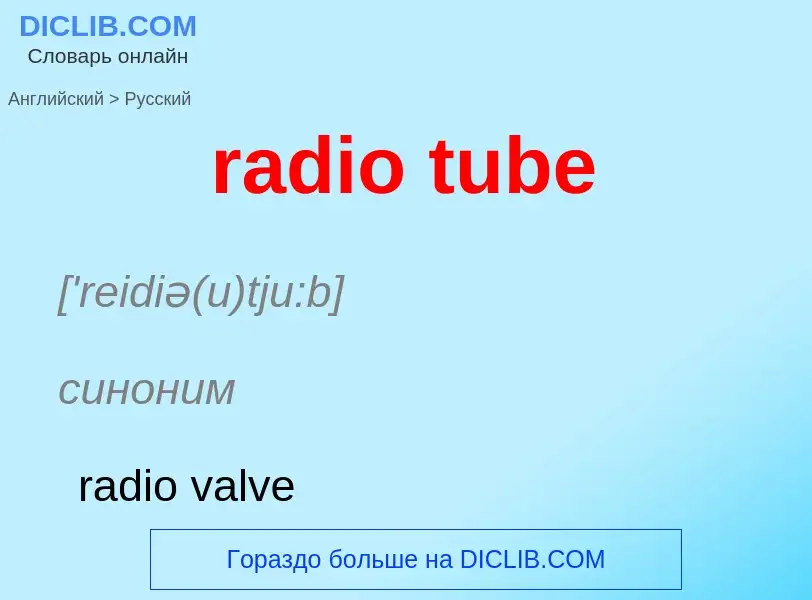Translation and analysis of words by ChatGPT artificial intelligence
On this page you can get a detailed analysis of a word or phrase, produced by the best artificial intelligence technology to date:
- how the word is used
- frequency of use
- it is used more often in oral or written speech
- word translation options
- usage examples (several phrases with translation)
- etymology
V T vacuum-tube - translation to russian
['reidiə(u)tju:b]
синоним
['reidiə(u)vælv]
общая лексика
электронная лампа
Definition
Wikipedia

A vacuum tube, electron tube, valve (British usage), or tube (North America), is a device that controls electric current flow in a high vacuum between electrodes to which an electric potential difference has been applied.
The type known as a thermionic tube or thermionic valve utilizes thermionic emission of electrons from a hot cathode for fundamental electronic functions such as signal amplification and current rectification. Non-thermionic types such as a vacuum phototube, however, achieve electron emission through the photoelectric effect, and are used for such purposes as the detection of light intensities. In both types, the electrons are accelerated from the cathode to the anode by the electric field in the tube.
The simplest vacuum tube, the diode (i.e. Fleming valve), invented in 1904 by John Ambrose Fleming, contains only a heated electron-emitting cathode and an anode. Electrons can only flow in one direction through the device—from the cathode to the anode. Adding one or more control grids within the tube allows the current between the cathode and anode to be controlled by the voltage on the grids.
These devices became a key component of electronic circuits for the first half of the twentieth century. They were crucial to the development of radio, television, radar, sound recording and reproduction, long-distance telephone networks, and analog and early digital computers. Although some applications had used earlier technologies such as the spark gap transmitter for radio or mechanical computers for computing, it was the invention of the thermionic vacuum tube that made these technologies widespread and practical, and created the discipline of electronics.
In the 1940s, the invention of semiconductor devices made it possible to produce solid-state devices, which are smaller, more efficient, reliable, durable, safer, and more economical than thermionic tubes. Beginning in the mid-1960s, thermionic tubes were being replaced by the transistor. However, the cathode-ray tube (CRT) remained the basis for television monitors and oscilloscopes until the early 21st century.
Thermionic tubes are still used in some applications, such as the magnetron used in microwave ovens, certain high-frequency amplifiers, amplifiers for electric musical instruments such as guitars, as well as high end audio amplifiers, which many audio enthusiasts prefer for their "warmer" tube sound.
Not all electronic circuit valves / electron tubes are vacuum tubes. Gas-filled tubes are similar devices, but containing a gas, typically at low pressure, which exploit phenomena related to electric discharge in gases, usually without a heater.











![Vacuum tubes seen on end in a recreation of the World War II-era [[Colossus computer]] at [[Bletchley Park]], England Vacuum tubes seen on end in a recreation of the World War II-era [[Colossus computer]] at [[Bletchley Park]], England](https://commons.wikimedia.org/wiki/Special:FilePath/GB-ENG - Bletchley - Computers - Buckinghamshire - Milton Keynes - Bletchly - Bletchley Park (4890148011).jpg?width=200)
![General Electric Company Pliotron, [[Science History Institute]] General Electric Company Pliotron, [[Science History Institute]]](https://commons.wikimedia.org/wiki/Special:FilePath/General electric pliotron pp schenectady 3.jpg?width=200)






![The first triode, the de Forest [[Audion]], invented in 1906 The first triode, the de Forest [[Audion]], invented in 1906](https://commons.wikimedia.org/wiki/Special:FilePath/Triode tube 1906.jpg?width=200)





